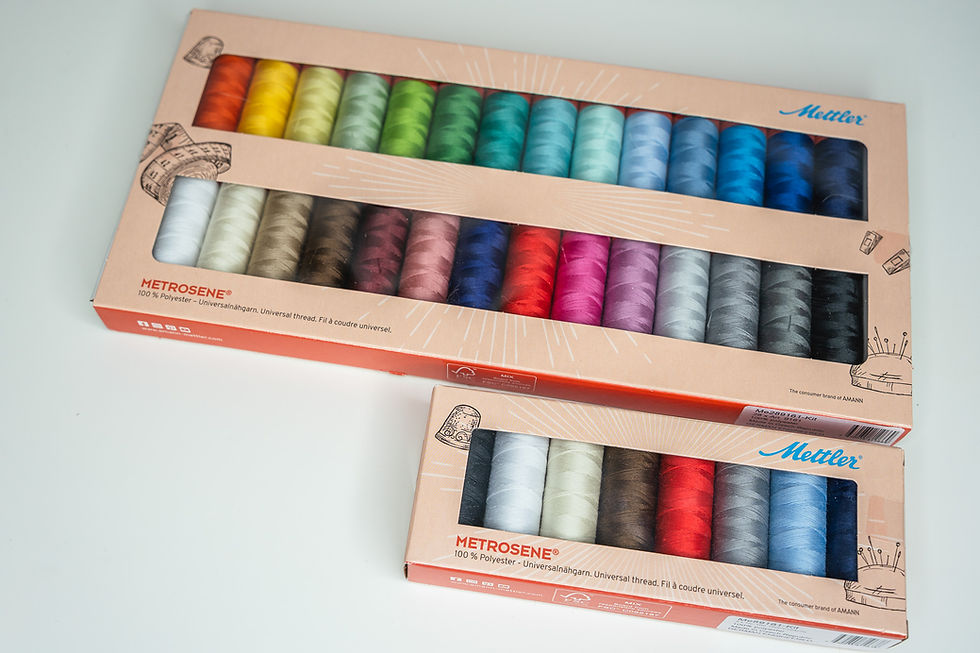Shirring Explained: master shirring in 6 steps
- julijadauc
- Jul 17, 2023
- 4 min read

I love shirring because it creates beautiful texture and keeps me comfortable because of the elastic. Shirring can be used making clothes and giving them unique texture, or as an easy alteration, like adding elastic waistband to a dress.
For this technique you'll need elastic thread which we will use in the bobbin and it will create those elastic gathers.

This tutorial is created in partnership with Mettler - manufacturer of high quality threads.

Founded in 1883 in Switzerland, Mettler has been a part of Amann group since 1988. Mettler threads are known for their high quality and broad range of colours, surface finishes, looks and effects. No matter what needlework project you are working on - sewing, quilting, embroidery or overlocking - Mettler will have the right thread for you!

I'll show you exact steps you need to take to get these beautiful shirring results. Click screen below to watch video or scroll to read the step-by-step guide!
6 Steps to Shirring Success
Step 1: use elastic bobbin thread.
This thread is very elastic and is used only in the bobbin. I use Mettler Elastic thread - I've used this thread in a lot of projects and I like that it keeps its elasticity even after multiple wears and washes. The thread comes in several colors, but most commonly you'll find this thread in either black or white color. Because this thread stays on the inside of the garment, there is no need to match color with fabric.

Step 2: wind Elastic to bobbin by hand.
This is key, because we don't want to pre-strech the thread before it goes into the seam
Wind the thread very gently, without pulling it, and install bobbin to place.
Step 3: use standard sewing thread at the top.
In this technique, elastic thread is used only in the bobbin, and top thread remains standard sewing thread. Today I'm using Mettler Metrosene as my top thread, which is an all-purpose thread. This thread will be visible from the garment outside, so match the color of the thread to the fabric.

Step 4. set sewing machine to longest straight stitch.
The longer the stitch - the more gathers you'll get. If you use short stitch, the fabric won't gather. I use 5mm length stitch.
Step 5: begin and end seam with back stitches.
It's important to secure the seam at the beginning and the back with back stitches, so that the seam does not pop.
Step 6: sew a straight seam and form gathers.
As we sew, the elastic thread gathers the fabric and creates beautiful ruffles. Important thing to note is that shirring lines are always sewn from the right side of the garment!
SEWING MULTIPLE SHIRRING LINES
Most commonly, you will want to sew multiple rows of shirring - in this method, I'll share how to move from one shirring line to another.

Step 1: draw straight lines on right side of the fabric.
Start by marking parallel lines with chalk on the right side of the garment.
Step 2: Sew along the line.
Start seam with a few back stitches and sew along the line using long straight stitch.
Step 3: Pull needle down and pivot to move between lines.
At the line end, pull needle down, lift presser foot, rotate fabric 90 degree. Reduce stitch length to minimum (I use 1mm stitch length) and sew until next line. Once you reach new line, repeat same steps: pull needle down, lift presser foot, rotate fabric and restore stitch length to max and sew until end of line.
Step 4: Continue with as many rows as you want.
Continue doing same steps with as many rows as you want: at line end, pull needle down, rotate fabric, reduce stitch length, sew until next line; then pull needle down, rotate fabric, increase stitch length and sew along the line.
Step 5: Finish seam with a few backstitches.
Once done you don't want to press shirring, because it will crush the gathers. Instead, give it a steam by holding the iron just above the fabric and it will make the gathers shrink even more.
SEWING SQUARE SHIRRING
One more way how to do shirring is by making square gathers, creating this beautiful, elastic structure.

Step 1: draw straight vertical and horizontal lines on right side of the fabric.
Start by marking parallel lines with chalk on the right side of the garment. To do it, first draw vertical lines and then horizontal lines, crossing each vertical line at 90 degree angle.
Step 2: sew all vertical lines.
Start by sewing all vertical lines. Move between lines using technique described in section 'Sewing multiple shirring lines'.
Step 3: sew all horizontal lines.
Once all horizontal lines are finished, sew along vertical lines. Move between lines using technique described in section 'Sewing multiple shirring lines'. Here important part is to open the fabric when you sew, so that you can see the line you need to sew.
Step 4: Finish seam with a few backstitches.
Once done you don't want to press shirring, because it will crush the gathers. Instead, give it a steam by holding the iron just above the fabric and it will make the gathers shrink even more
After all horizontal lines are finished, here is the texture you'll get
I hope you enjoyed learning about shirring! If you want to try out shirring, here are a few projects that you can try next:
Add elastic waist to any dress:
Gathered sundress (no pattern needed!):
Gorgeous shirred dress (with pattern download):







Comments